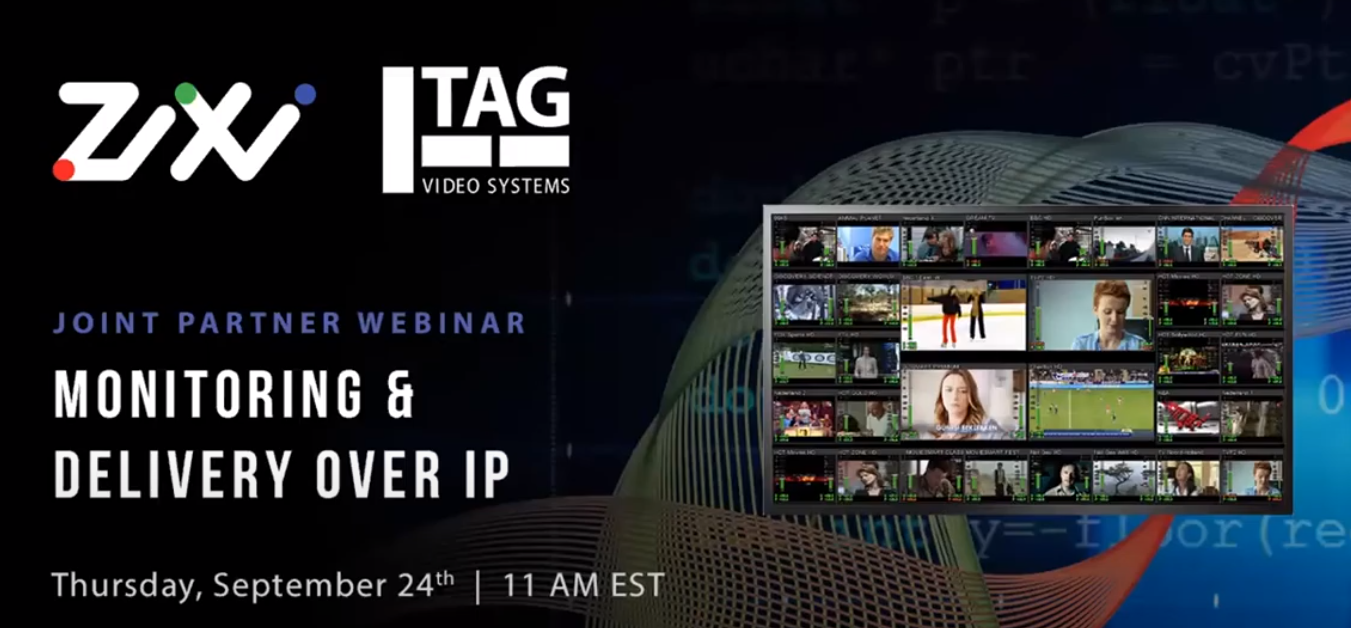
Joint Zixi, TAG Solution Easily Enables Cloud-Based Applications
Zixi and TAG Video Systems teamed up to offer a joint technology solution that the companies say allows broadcasters and content distributors to easily enable cloud-based applications, reduce costs and conduct proactive monitoring and delivery of live video at scale.
TAG’s MCM-9000 multiviewer and monitoring system now offers native support for Zixi input and output transport streams, eliminating the need for outbound processing or servers, according to the companies.
“There’s been an accelerated shift away from traditional, inflexible hardware-based infrastructures towards more flexible, software-defined solutions,” Gordon Brooks, CEO and executive chairman of Zixi, said Sept. 24 during the webinar “Monitoring and Delivery Over IP with TAG VS.”
“There’s a lot of factors that are driving this,” including the “rise of consumer cord-cutting,” he noted.
Meanwhile, another factor is the “faster time to market [has] required the proof that five nines and six nines [reliability] is easily achievable with IP with the right solution,” he said.
He pointed to a few other major factors: “The rapid move to cloud virtualization and the need for more cost-effective, flexible broadcast infrastructure; the unrelenting pressure to cut costs and avoid the cost of inflexible, dedicated video links, ethernet and satellite; 5G and its impact; and, not to mention, COVID having an impact on everything we’re doing.”
All of that comes “while we’re trying to maintain broadcast quality of service and quality of experience,” he told viewers.
“TAG and Zixi have been working side by side” to develop their joint solution for monitoring and reliable transport over IP, and they are now “finally having end-to-end integration” to the TAG MCM-9000, he said. That will “provide a complete multi-channel on-prem and remote monitoring solution for all live video transmission layers [when] combined with the Zixi Software-Defined Video Platform for low latency, reliable transport delivery and congestion-aware network adaptive protocol, overcoming connectivity challenges with remote production.”
The joint solution “allows us to use the unmanaged networks to transport professional, reliable video signals at a super low latency at broadcast quality, [and] to also proactively monitor and receive alerts on streams across transmissions, and to identify impairments and address transport issues,” he said.
Zixi supports 17 protocols in all, including its own Zixi protocol, but “we’ll support every available popular protocol on the market [and] we’re integrated into all the major cloud providers and we are integrated in many, many edge devices,” he pointed out.
Currently, over 100,000 instances of Zixi are deployed globally, in well over 100 countries and Zixi has over 700 media customers and more than 200 integrated technology partners, according to the company.
Brooks went on to provide the five core characteristics of a software-defined video platform: 1. It’s software-defined and, by nature, virtual, while offering ease of connectivity and can be quickly deployed. 2. It’s scalable, with adaptive architecture “because things are changing all the time.” 3. It’s data driven. 4. It provides quality of experience with no resolution limit. Noting Zixi is now testing 8K over 5G in the Verizon labs, he said “we’re really pushing the limits and you really need to make sure the software doesn’t provide a limitation.” 5. “It really needs to be future proof.”
The latter core characteristic is crucial because “the world’s changing and the world’s changing rapidly,” he said, adding: “Protocols are changing….so you need universal interoperability. You need to support any protocol, any network, any cloud, any edge device. And it also needs to be committed to standards so, as standards emerge, then they need to be incorporated and built into whatever software-defined video platform you decide to use.”
Paul Briscoe, chief architect at TAG VS, went on to point out that his firm is now monitoring over 50,000 channels with the world’s largest broadcasters, and serves the four largest broadcasting applications: Live production, playout/master control, distribution and over-the-top.
To view the full webinar, click here.
